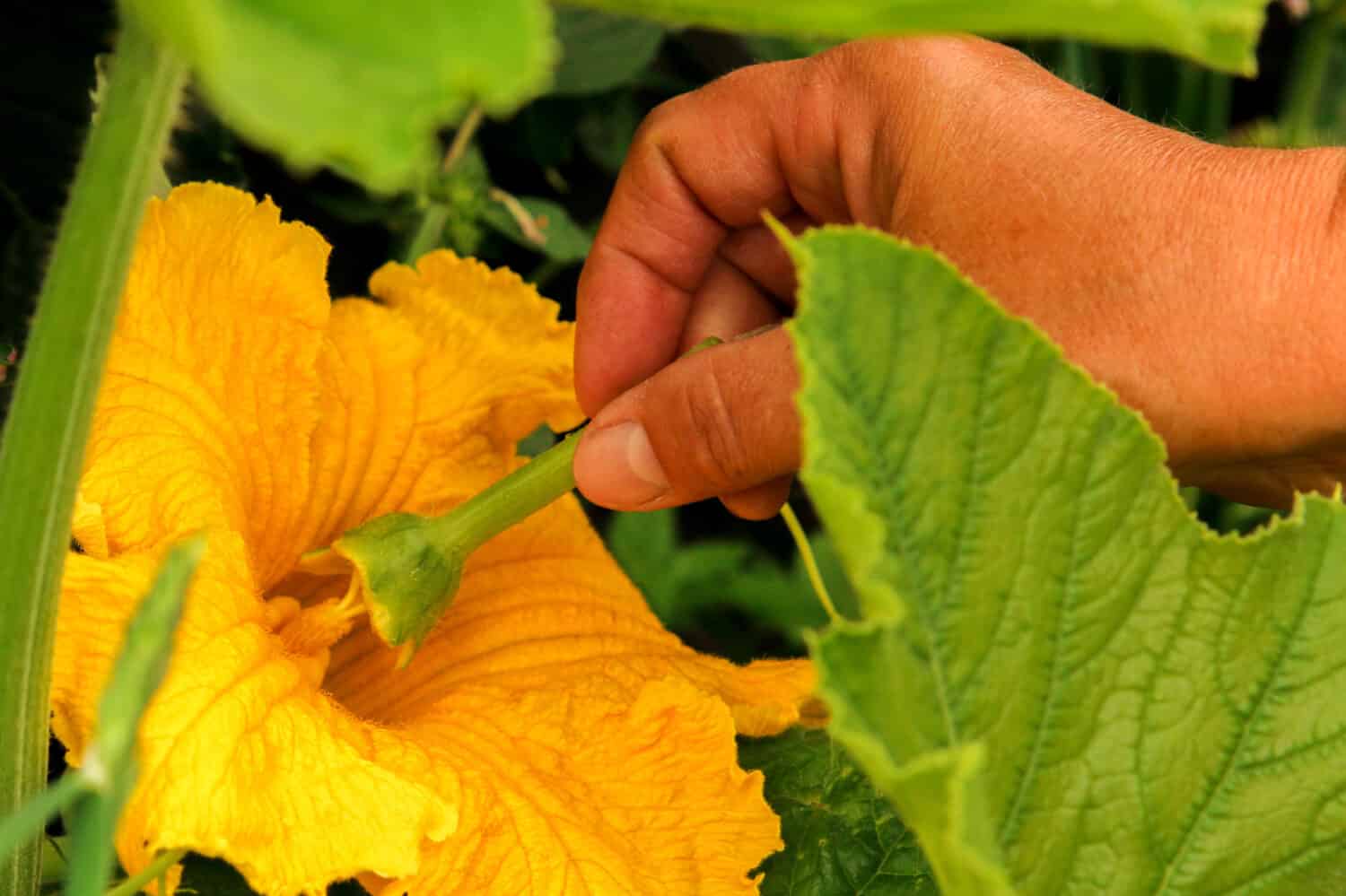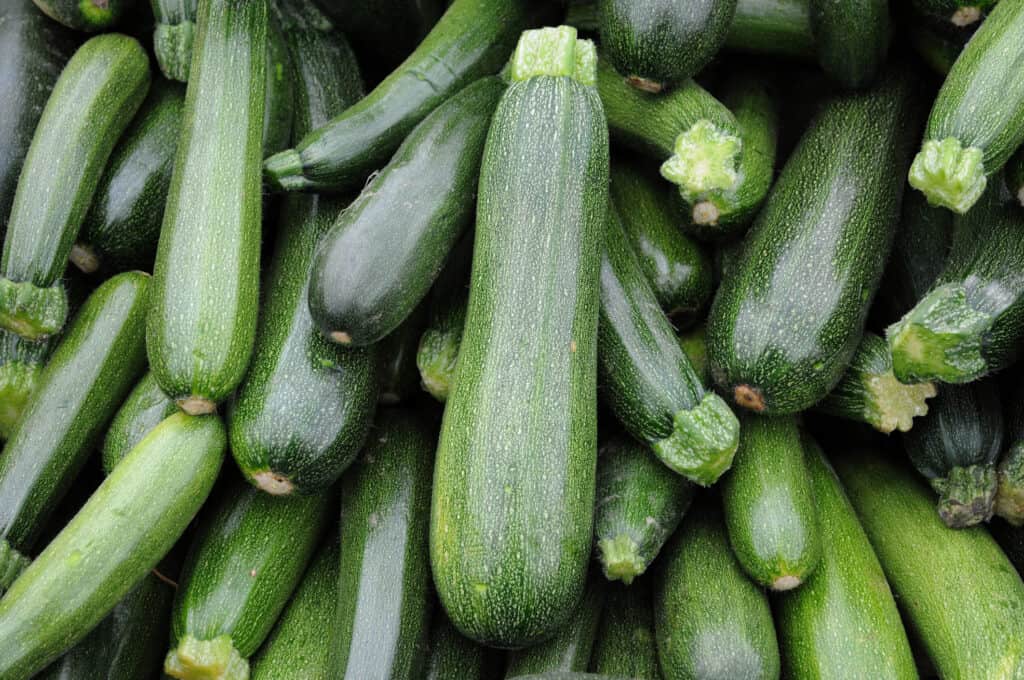Welcome to our informative article on identifying the distinctions between male and female zucchini flowers! Understanding these differences is crucial for successful pollination and maximizing your vegetable harvest. In this concise guide, we’ll delve into the various visual cues that can help you discern between the two sexes of zucchini blossoms, enabling you to become a skilled gardener in no time.
What is a Zucchini?

Zucchini plants can produce very large harvests.
©iStock.com/Cineberg
A zucchini is a summer squash that is cylindrical in shape and has dark green skin. It is a type of cucurbit, meaning it is related to cucumbers, pumpkins, and other squash. Zucchinis are popular in cooking and very versatile.
Growing zucchinis is fairly easy. Gardners should plant them in an area with plenty of sunlight and water regularly. Zucchini plants often produce a lot of fruit, so it is best to thin the plants to ensure plenty of space for the zucchini to grow.
Zucchinis have a mild flavor and a tender texture. You can enhance their flavor by adding herbs and spices. People love to eat them raw, cooked, or even pickled.
There are many ways to use zucchinis. People eat them as a side dish, add them to soups and stews, or even use them to make muffins or bread. You can also fry, grill, or roast zucchini.
Zucchinis are a great addition to any meal. They are easy to grow, have a mild flavor, and are very versatile. Whether you are looking for a side dish, a main course, or even a dessert, zucchinis are sure to be a hit.
Male vs. Female Zucchini Flowers: How to Spot the Differences

The easiest way to tell the difference between male and female zucchini flowers is that females have fruit growing behind them, and males only have a slender stem.
©Robert Schneider/Shutterstock.com
Zucchini plants produce both male and female flowers, and for the plants to bear fruit, pollination must occur between them. Male flowers typically open first and release pollen, then drop off the plant. Female flowers must stay attached until the zucchini develops, which only happens if pollination is successful. If not, the female flowers will also fall off, and the plant won’t produce any fruit.
Anatomically, there is a distinction between male and female flowers: the pollen-producing parts of the male flower are the anthers and filaments on the stamen, which are often merged together, while female blossoms are connected directly to the fruit. Male blossoms have long slender stems.
To differentiate between male and female zucchini blossoms, look for the stem. Male flowers will have a longer stem, while female flowers will be directly attached to the fruit. Additionally, examine the base of the flower – a swollen base indicates that it is a female flower, which will later become the zucchini after germination.
It is possible to tell the difference between male and female zucchini flowers by examining them closely. Male blossoms have one long stamen in the center of the flower with pollen on it, while female zucchini flowers have a stigma with many stems inside. Only female flowers will mature into squash. The male is only there to fertilize the flowers. Male flowers tend to be more numerous and bigger than female ones.
A Chart Explaining Male vs. Female Zucchini Flowers
| Male Zucchini Flower | Female Zucchini Flower |
|---|---|
| One single stamen that is covered in orange pollen | Stigma with multiple stems inside. It looks like a tiny flower inside the flower. |
| A thin stem with no swollen base | A small bulbous mini-zucchini behind the flower |
| More quantity | Less quantity |
| Earlier in the season by two weeks | Later in the season, blooms after male flowers |
| Longer sepals | Shorter sepals |
| The pedicel supporting the flower is thinner | The pedicel supporting the flower is thicker |
How to Hand Pollinate Zucchini

You can pick the male zucchini flowers, and hand pollinate the female flowers for a larger yield.
©masterpiece creator/Shutterstock.com
Rather than relying on bees to transfer pollen from male flowers to female flowers, it is possible to manually pollinate the female blooms. To do this, use a cotton swab to collect pollen from the male flowers and then gently rub the pollen onto the female flowers’ stamen. This will cause the female flower to produce fruit.
To ensure that the zucchini yields a good amount of fruit, make sure to provide it with at least 6-8 hours of direct sunlight and avoid extremely hot temperatures above 85 degrees Fahrenheit during flowering.
Hand-pollinating zucchini plants is possible by taking a male flower from the vine, removing the petals, and dabbing the stamen inside a female flower. To get the best fruit production, one should do this early in the morning while the flowers are still open. If there are enough bees or other beneficial insects around, they will take care of pollination for you. It is not unusual for the squash plants to produce more male flowers earlier in the season.
Zucchini Flowers are Edible—How to Eat Them

Another great way to eat zucchini flowers is to batter and fry them.
©Lunov Mykola/Shutterstock.com
Edible zucchini flowers can be cooked and eaten, with the pistils of female flowers and stamens of male flowers both being edible and having flavor. Many people remove the internal parts of the flower before cooking, but this is not necessary.
It is simple to recognize male and female zucchini flowers by the difference in their stems. The female flower stems have a swollen base that looks like a mini zucchini. Use scissors or a sharp paring knife to cut the flowers off of the stem, leaving about one inch of the stem attached. It is important to leave some male flowers in order to ensure the bees pollinate the female flowers.
To intensify the taste, cooks may opt to dehydrate the flowers, which can also be a great garnish. To preserve them longer, one can vacuum-pack the dehydrated blossoms for use in the winter months.
Male zucchini flowers don’t produce any fruit, so you can pick them without losing any of the squash crops. With their delicate texture and a taste similar to summer squash, you can enjoy them either raw or cooked. You can stuff them, batter and fry them, or bake them into bread or pizza. They will be a delicious addition to any meal!
I Don’t Have Female Flowers on My Zucchini—Why?

If the temperatures are too hot and dry, your zucchini plants may not develop properly.
©iStock.com/Pack-Shot
When squash is planted in the summertime, it is typical to observe a lot of male flowers rather than female ones. This can occur when daily temperatures reach above 90°F, and nighttime temperatures stay over 70°F. It is likely that the plant is attempting to conserve energy for when it actually can begin the process of pollinating, which explains why there are more male flowers under these conditions. To boost the number of zucchini flowers, it is necessary to take steps to reduce the amount of stress on the plant.
Fertilizing your squash plants is key to ensuring they grow strong and vibrant. But too much fertilizer can lead to a decrease in female zucchini blooms, as an overabundance of nitrogen in the soil can cause only male flowers to appear. Even though the foliage will look lush and dark green, the female flowers won’t show up.
How To Increase the Number of Zucchini Flowers

This is a female zucchini flower. Notice the multiple stamens that look like a tiny flower inside of a larger flower.
To increase the number of zucchini flowers, make sure the temperatures are below 90 degrees Fahrenheit during the day and below 70 degrees Fahrenheit at night. This will result in more female flowers than male ones. If you don’t have a greenhouse with a thermostat, plant squash in the early spring so that female flowers can bloom before summer temperatures become too hot.
The placement of squash plants is essential, yet gardeners often overlook this part of cultivation. To encourage the production of female flowers, it is important to make sure that each plant is at least 24 to 30 inches away from each other.
Are you concerned that the female zucchini flowers on your plant are not blooming, even in cool weather? Watering could be the answer. Many horticulturists have observed that female flowers are more likely to grow if the soil is kept moist. Conversely, having soil that is mostly dry can lead to more male flowers. Ensure that you are providing your plant with two inches of water twice each week during the summertime.
You can also provide mulch and remove weeds to keep the ground cool and reduce stress on the zucchini plants. With these tips, your plants will grow multitudes of both male and female zucchini flowers in no time!
Thank you for reading! Have some feedback for us? Contact the AZ Animals editorial team.







